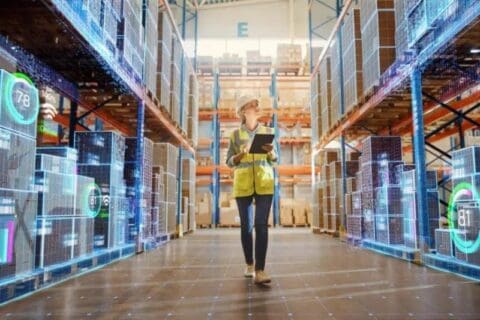When it comes to logistics, the efficient tracking and management of assets and inventory are critical. For years, Radio Frequency Identification (RFID) has been the go-to solution. However, as technology evolves and scalability becomes a more pressing concern, Bluetooth Low Energy (BLE) is emerging as a more cost-effective and versatile alternative. Understanding the key differences between these technologies can help businesses decide which one is the best solution for their operational needs.
Understanding RFID
RFID has been widely adopted in supply chain and logistics industries for tracking assets, inventory, and goods in transit. RFID systems use radio waves to read information stored on tags attached to items. An RFID reader can scan these tags at various distances, depending on the type of RFID system (passive, active, or semi-passive). However, this out-of-date technology – which has been around since the 1940s – comes with significant drawbacks:
– High Equipment Costs: RFID readers typically cost between $1,500 and $3,000, which makes large-scale deployment expensive. The average warehouse for a medium-sized business is about 40,000 square feet, meaning you would need to spend more than $65k on 30 RFID readers for adequate coverage.
– Proprietary Systems: RFID systems generally operate within their own proprietary setups, meaning they are often incompatible with other systems or technologies like smartphones, tablets, or Bluetooth-enabled devices.
– Limited Flexibility: Because RFID readers and tags work within a closed system, integrating RFID requires costly hardware, software, and infrastructure changes.
– Planned Obsolescence: RFID systems require periodic upgrades, with companies typically needing to replace and/or upgrade their RFID readers every few years. This planned obsolescence increases long-term costs and operational disruptions.
What is BLE, and How Does It Work?
BLE (or Bluetooth Low Energy) is a wireless communication technology that has become ubiquitous across many industries due to its low power consumption, ease of integration, and compatibility with everyday smart devices – and it is now gaining traction for smart supply chain applications.
BLE is a subset of the Bluetooth standard, designed specifically for applications that require low energy usage, such as asset tracking tags, smart home systems, and IoT devices. BLE readers, such as smartphones, tablets, or dedicated BLE gateways, detect and receive signals from nearby BLE tags or beacons. These tags periodically broadcast small packets of data, such as location or sensor information, which the readers pick up. The readers then relay this data to a central system for processing, allowing for real-time tracking and monitoring of assets or environmental conditions. BLE technology offers several advantages that are helping drive its adoption as a replacement for traditional RFID solutions in asset tracking:
– Cost-Effectiveness: BLE requires a much less expensive infrastructure compared to RFID. Many businesses already use BLE-enabled devices like smartphones, tablets, and computers, which can easily communicate with BLE tags or sensors.
Businesses can further reduce costs by using battery-less BLE devices, which eliminate the need for frequent battery replacements and maintenance. These devices are energized via a wireless power network (WPN) which enables them to be continuously charged in place. This not only cuts down on operational interruptions but also lowers long-term maintenance costs. The simplicity of the BLE devices combined with the efficiency of a WPN enables businesses to create truly autonomous, low-maintenance IoT systems at a fraction of the cost of traditional RFID or battery-dependent BLE solutions.
– Scalability: BLE’s open standard allows for easier scalability. Unlike RFID, which often necessitates specialized hardware, BLE can integrate with existing infrastructure, making it ideal for businesses looking to expand operations without massive upfront investments.
– Widespread Compatibility: One of BLE’s biggest strengths is its compatibility with a wide range of modern devices. Almost every smartphone, tablet, and computer supports Bluetooth, meaning BLE can be accessed without additional hardware purchases.
– Real-Time Data: BLE enables real-time tracking of assets, just like RFID, but its flexibility in integration means that companies can access the data through common platforms like smartphones or tablets without needing proprietary readers. With the latest innovations in wireless power solutions, data streams at the edge are always active, providing 24/7 tracking. Furthermore, BLE technology offers high level of visibility and process automation reducing to almost zero any type of human intervention.
RFID vs. BLE: Head-to-Head Comparison
While both RFID and BLE are used for asset tracking, the following factors highlight why BLE is becoming a more popular choice:
Transforming Asset Tracking with Battery-free BLE
While BLE is already having an impact on how companies track their assets, Energous Wireless Power Solutions is enabling the technology to deliver even greater visibility, control, and automation.
Energous PowerBridge transmitter systems use RF waves to deliver wireless power to devices while simultaneously enabling real-time data communication over BLE. They are the backbone of WPNs that allow devices such as sensors and tags to continuously provide critical enterprise data to cloud networks—at distance and without wires, batteries, or cables—ensuring they are reliably charged at all times. In addition, they act as data links, enabling the devices to efficiently communicate valuable data and insights back to the cloud, and allowing companies to analyze, optimize, and improve every part of their supply chain operations in real time.

Wireless Power: Revolutionizing The Manufacturing Sector
The company is growing its wireless energy solution to power BLE tags with new certification for use in Japan, and has teamed up with InnoTractor and Thinaer.

Unlocking the Future with Energous’ Radio Frequency Wireless Charging
Energous advances RF wireless charging, offering versatile and cost-effective power solutions that redefine efficiency and convenience in various sectors from healthcare to IoT.

About Energous
Pushing the boundaries of power, Energous leads the way in wireless power solutions. With over 200 patents, 30+ PoCs, and regulatory certification in 114 countries, Energous leverages its global expertise to deliver cutting-edge technology for IoT markets. Energous solutions enable efficient over-the-air power transmission as well as data transmission over

